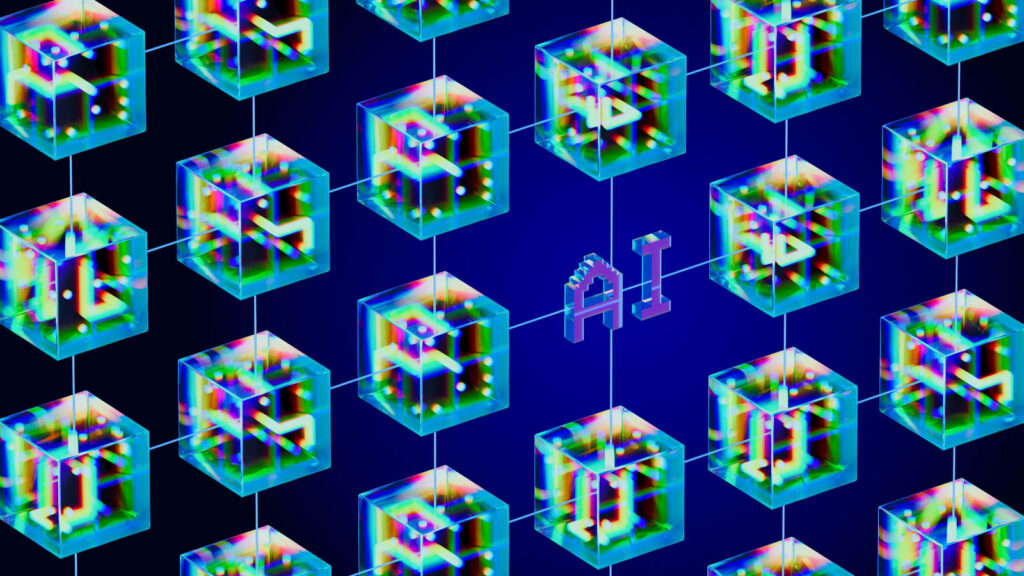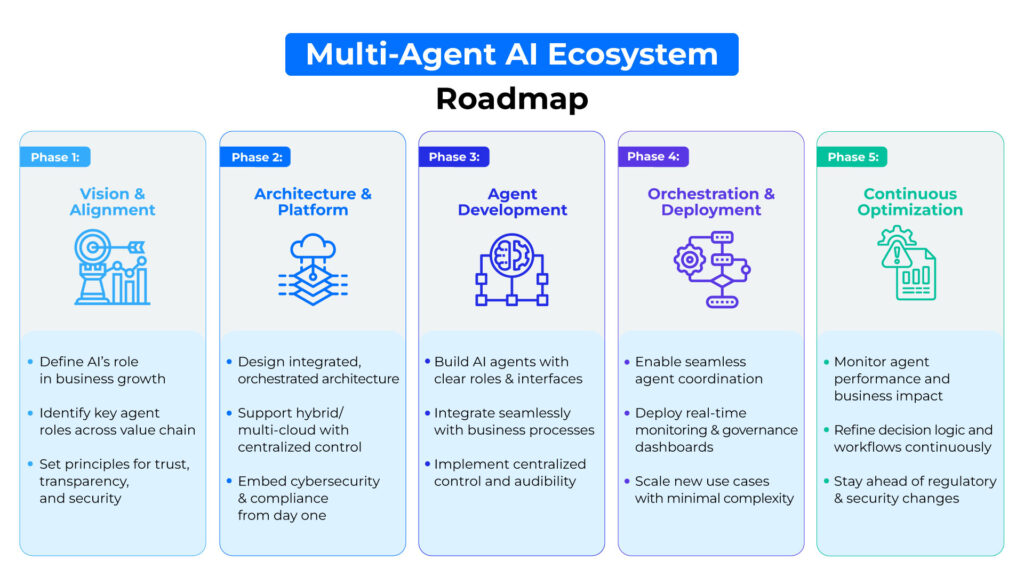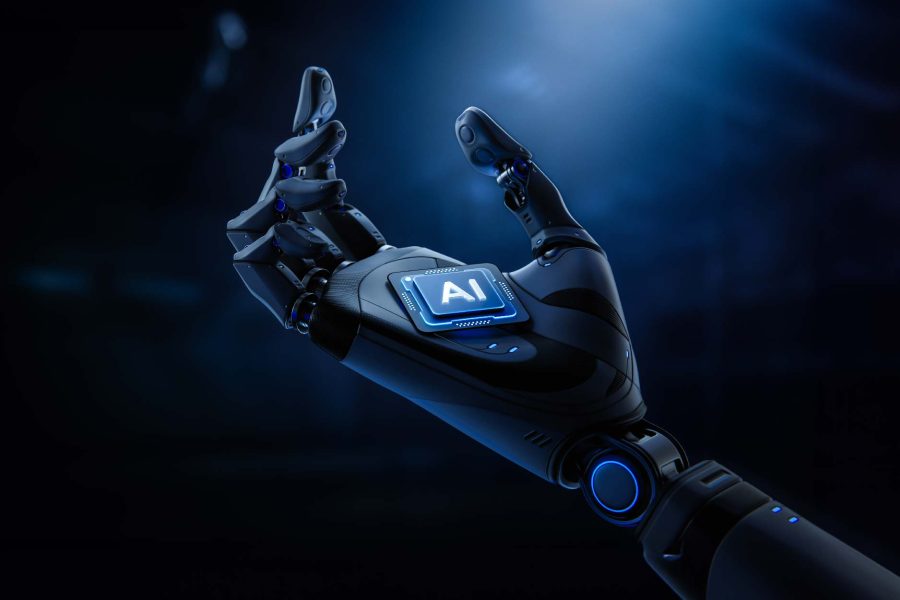From AI Silos to Unified Intelligence: The New Enterprise Imperative
The illusion of progress is dangerous. More AI doesn’t mean smarter business—especially when systems can’t talk to each other.
In today’s race to unlock competitive advantage through AI, many organizations rush to deploy tactical solutions — chatbots for customer service, fraud detection engines, or risk scoring models. These initiatives often deliver isolated wins—but without a unifying architecture; they create fragmentation, not transformation.
What emerges is a silent threat: AI silos. Disconnected systems that can’t share insights, coordinate decisions, or scale collaboratively. Complexity mounts. Costs rise. Strategic value gets lost in translation.
Strategic orchestration is essential to elevate AI from fragmented victories to enterprise-wide impact.
🧠 Why AI Silos Are a Strategic Threat
Most organizations begin their AI journey by addressing functional pain points. Sales teams deploy lead-scoring models. Operations build forecasting tools. Finance implements fraud detection systems. Individually, these solutions work. Collectively, they don’t scale.
As AI investments grow, so do the silos. Without integration, AI systems operate in isolation—unable to access shared data, align decisions, or deliver enterprise-wide value. What began as innovation quickly became technical debt.
This is not just an IT problem. It’s a business risk.
🚨 What AI Silos Actually Cost You
Siloed AI is more than inefficient—it poses systemic risks to enterprise stability. Below are the hidden threats that organizations often underestimate until it’s too late:
- Flawed Decisions from Incomplete Data
AI models without access to enterprise-wide information tend to make narrow, conflicting, or even detrimental decisions.
- Compounding Complexity Kills Scalability
Every standalone model adds technical debt—requiring separate infrastructure, custom integrations, and additional oversight. Scaling becomes exponentially harder.
- Operational Fatigue Drains IT and Data Teams
Without standardized protocols, teams must manage redundant governance tools, fragmented tech stacks, and inconsistent security frameworks—draining resources and morale.
- Compliance Blind Spots Multiply
Decentralized oversight makes it nearly impossible to enforce consistent compliance with regulations such as GDPR, PDPA, or ISO standards.
- Innovation Slows to a Crawl
Without interoperability, insights and capabilities remain siloed. Reusing models or compounding their value becomes technically prohibitive.
- Cybersecurity Risks Escalate
Each isolated system becomes a unique attack surface. Without centralized visibility and control, your overall security posture weakens.
- Customer Experience Fractures
Disconnected AI means disjointed customer touchpoints—leading to inconsistent service, fragmented experiences, and eroded trust.
These issues don’t just delay progress—they erode enterprise value. Avoiding them requires a shift toward coordinated, enterprise-grade AI integration.
✅ What Is a Multi-Agent AI Ecosystem—and Why It Changes the Game
The solution to AI fragmentation isn’t just better models—it’s better coordination. That’s where the Multi-Agent AI Ecosystem comes in: a strategic architecture in which AI agents are assigned clear roles, operate in synchrony, and deliver compound business value at scale.
Instead of standalone systems operating in silos, a Multi-Agent approach enables AI models to collaborate across the enterprise value chain—analyzing, deciding, and acting as one integrated system.
🤖 What Is a Multi-Agent AI Ecosystem?

A Multi-Agent AI Ecosystem is a structured system of AI agents—each with a clearly defined role—working in concert to deliver seamless, end-to-end outcomes.
- 🔹 Insight Agent: Synthesizes data from multiple sources to uncover actionable insights.
- 🔹 Decision Agent: Applies logic, business rules, and AI models to make strategic choices.
- 🔹 Action Agent: Executes business processes autonomously, triggered by events or decisions.
Example Workflow:
Trigger: A new customer signs up via your website
Action Agent: Validates information, generates a customer profile in the CRM, and sends a personalized welcome email within seconds
The real breakthrough? These agents don’t just work—they work together.
Without orchestration, AI systems remain disjointed: one may analyze but not decide; another may decide but not execute; a third may execute—but without contextual awareness.
🤝 From Coexistence to Coordination
Multi-Agent AI Ecosystem is not about stacking more AI tools—it’s about designing systems with collaboration at their core. It’s about engineering interoperability into your AI infrastructure from the ground up.
When executed properly, this model unlocks a new operating paradigm:
AI that thinks strategically, acts autonomously, and scales reliably—across every part of the business.
🚀 Multi-Agent AI in Action: Real-World Business Impact
Multi-Agent AI is no longer a conceptual ideal—it’s already being deployed by leading enterprises to solve complex challenges, spark innovation, and accelerate business outcomes.
Here’s how top organizations across industries are transforming operations through coordinated AI agents:
✅ Customer Service Transformation — NICE CXone Mpower
Challenge: Disconnected service tools led to inconsistent customer experiences and longer resolution times.
Solution: NICE CXone Mpower deployed a Multi-Agent AI system in which:
- Insight Agents interpreted customer intent and past interactions
- Decision Agents generated tailored responses and relevant offers
- Action Agents instantly executed those responses—triggering follow-up messages or targeted campaigns
Result: Significantly enhanced response times, customer satisfaction, and operational efficiency.
✅ Predictive Maintenance in Manufacturing — Siemens
Challenge: Unplanned equipment downtime disrupted production lines and drove up maintenance costs.
Solution: Siemens implemented a Multi-Agent AI system that:
- Continuously monitored sensor data in real time
- Anticipated potential failures before they occurred
- Automatically dispatched technicians with customized maintenance protocol
Result: Reduced downtime and improved asset reliability, and workforce efficiency.
✅ Autonomous Trading in Finance — JPMorgan (LOXM)
Challenge: Manual trading strategies were unable to respond quickly enough to volatile market conditions.
Solution: JPMorgan deployed LOXM, a Multi-Agent AI system purpose-built for trading, to:
- Monitor real-time market data continuously
- Calculate buy/sell positions with algorithmic precision
- Execute trades autonomously in milliseconds
Result: Dramatically increased trading speed and accuracy while significantly reducing costs—setting a new benchmark for high-frequency trading.
✅ Logistics Optimization — AnyLogistix
Challenge: Legacy planning systems failed to provide the real-time agility needed in fast-changing logistics networks.
Solution: AnyLogistix implemented a Multi-Agent AI system to:
- Analyze real-time inventory data and optimize shipping routes
- Predict potential risks and delivery disruptions
- Automatically generate and adjust shipment plans across multiple regions
Result: Enhanced supply chain agility and responsiveness, while driving down logistics costs.
✅ M&A Acceleration — Nextoria Team-GPT
Challenge: Traditional due diligence and deal analysis processes were slow, manual, and consumed significant time and resources.
Solution: Nextoria implemented Team-GPT, a Multi-Agent AI solution that:
- Rapidly processes large volumes of due diligence documentation
- Automatically identifies red flags and potential deal risks
- Generates real-time, executive-ready summaries for internal and client use
Result: Cut deal closure time by up to 35%, accelerating decision-making and enabling faster strategic execution.
🏗️ Centralized Architecture: Aligning Intelligence Around a Single Source of Truth
A centralized architecture provides the foundational framework for unifying all AI agents under a single source of truth. It ensures:
- Consistent data integrity across business functions and AI models
- End-to-end transparency for governance, monitoring, and auditability
- Uniform enforcement of security protocols and compliance standards
- Simplified scaling of future AI initiatives without compounding complexity

This goes beyond technical infrastructure. It’s about designing an AI ecosystem that is intelligible, governable, and future-proof from the start.
🎯 Orchestration: Making AI Collaboration Work in Practice
Orchestration is the critical mechanism that enables AI agents to operate as a cohesive system. It manages the coordination of:
- Data Flow — ensuring each agent receives the right data at the right time to perform its role effectively
- Process Flow — synchronizing both sequential and parallel tasks to maintain efficiency and alignment
- Decision Flow — integrating logic, business rules, and model outputs to support seamless, enterprise-wide decision-making
Without orchestration, even the most advanced AI models operate in silos—talented but unaligned.
With orchestration, they function as a unified, intelligent network—thinking, acting, and evolving together.
Strategic Roadmap for a Scalable and Resilient Multi-Agent AI Ecosystem

Creating a future-ready AI ecosystem goes beyond deploying standalone models—it requires a clear, enterprise-wide transformation strategy. This roadmap must tightly align AI initiatives with core business objectives while embedding long-term resilience, seamless interoperability, and the ability to scale.
Below are five critical phases to guide the systematic implementation and scaling of a Multi-Agent AI Ecosystem:
🚀 Phase 1: Vision & Strategic Alignment
- Clearly define AI’s strategic role in advancing core business objectives
- Map out essential agent roles across the enterprise value chain
- Establish foundational principles for trust, transparency, security, and compliance from day one
🧠 This phase grounds your AI initiatives in strategic purpose and ensures they are positioned for measurable, enterprise-wide impact.
🚀 Phase 2: Architecture and Platform Design
- Design an integrated orchestration architecture that aligns data, process, and decision flows
- Enable hybrid or multi-cloud infrastructure with built-in flexibility and centralized control
- Embed cybersecurity, access governance, and compliance-by-design into the system architecture
🛠️ This phase ensures that governance and infrastructure are seamlessly unified—laying the groundwork for secure, scalable, and resilient AI intelligence.
🚀 Phase 3: Agent Development and Integration
- Develop AI agents with clearly defined scopes, responsibilities, and standardized interfaces
- Integrate agents seamlessly into core business processes and decision-making loops
- Implement centralized control mechanisms including unified policy enforcement and comprehensive audit trails
🔗 This phase connects intelligence with execution—ensuring AI agents not only function effectively but also collaborate as a unified system.
🚀 Phase 4: Orchestration and Scalable Deployment
- Activate orchestration logic to enable seamless coordination among AI agents
- Deploy intelligent monitoring and governance dashboards for holistic ecosystem visibility
- Scale new AI use cases and agents while minimizing operational complexity
📈 The ecosystem becomes a dynamic, modular system capable of evolving without friction.
🚀 Phase 5: Continuous Optimization
- Track AI agent performance, risk signals, and business impact in real time
- Continuously refine decision logic, process workflows, and integration layers
- Proactively adjust to evolving regulatory, cybersecurity, and operational requirements
🔄 Sustainable AI isn’t static—it evolves through constant refinement, ensuring long-term resilience and value.
🔐 Security and Compliance: A Strategic Enabler of Multi-Agent AI Success

Creating a secure and auditable Multi-Agent AI Ecosystem requires more than technical robustness—it calls for security and compliance to be embedded into the architecture from day one.
To achieve operational resilience and regulatory alignment, enterprises should proactively implement the following pillars:
✅ Data Lineage & Traceability
Maintain full visibility into data sources and flow between agents, supporting transparent audits and incident resolution.
✅ Granular Access Control
Establish fine-grained permissions to govern who can access, modify, or trigger specific agents—minimizing risk and enforcing accountability.
✅ Real-Time Monitoring
Deploy intelligent monitoring tools to detect anomalies and threats in real time—enabling rapid mitigation and threat response.
✅ Compliance-Ready Architecture
Engineer systems to meet standards such as NIST, ISO, PDPA, and GDPR—embedding compliance into operational design.
✅ End-to-End Auditability
Log agent behavior, decision rationale, and data activity in centralized, immutable systems—ensuring traceability and regulatory defense.
In an interconnected AI environment, where autonomous agents act on behalf of the business, security and transparency aren’t just safeguards—they are strategic enablers of enterprise trust, innovation, and scalable growth.
🤝 Bluebik: Your Strategic Partner in Building a Scalable, Secure, and Insight-Driven Multi-Agent AI Ecosystem
Bluebik is your trusted partner in realizing the full potential of Multi-Agent AI. Backed by deep cross-functional expertise in business, technology, and governance, we provide end-to-end strategic guidance to help enterprises build AI ecosystems that scale with confidence.
Our comprehensive services include:
- AI Strategy & Roadmap — aligned with your business priorities and long-term vision
- Architecture & Orchestration Blueprint — tailored for hybrid and multi-cloud environments
- Governance Framework Design — embedding cybersecurity, compliance, and auditability by design
- Business Process Integration Consulting — enabling seamless collaboration between AI agents and enterprise workflows for measurable results
At Bluebik, we believe that a strong architectural foundation laid from day one is essential for eliminating hidden integration costs, simplifying future expansion, and driving secure, scalable, and outcome-driven AI transformation.
Let’s build an intelligent future—together.











![Thumbnail [Post Event] HOW](https://bluebik.com/wp-content/uploads/2025/12/Thumbnail-Post-Event-HOW.png)
